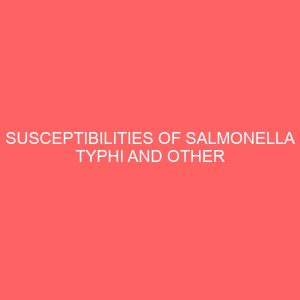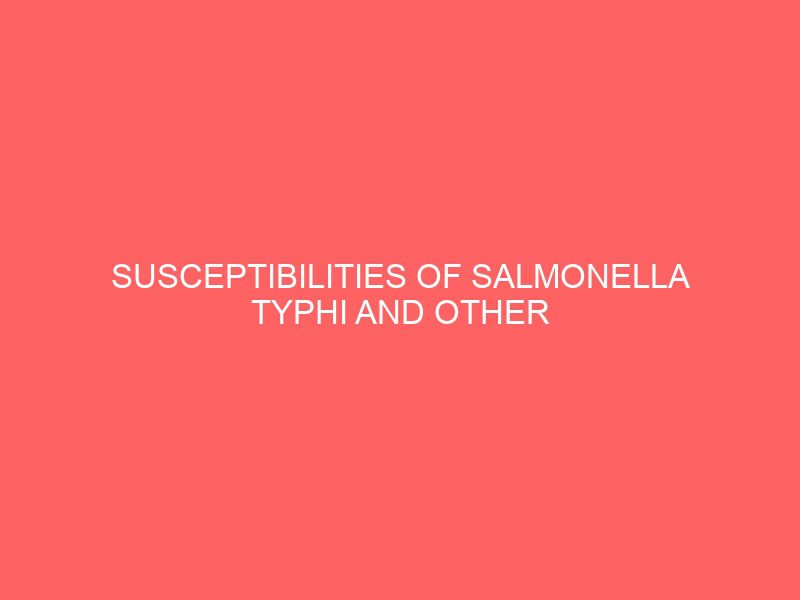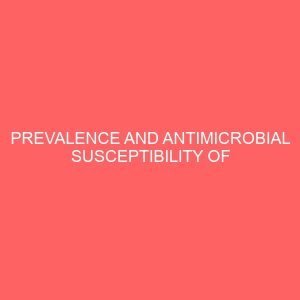Description
ABSTRACT
The susceptibilities of Salmonella typhi and other pathogens to antibiotics and hot aqueous extract of Hibiscus sabdariffa were investigated using agar diffusion and agar well diffusion methods respectively. Salmonella typhi was sensitive to ampicillin, cetriaxone, ciprofloxacin, gentamycin of ofloxacin and perfloxacin. Nitrofurantoin, ampicillin, clarithomycin and augumentin are resistant. Escherichia coli, Klebsiella spp, and Staphylococcus aureus were sensitive to 50, 70 and 60 of the antibiotics respectively. Pseudomonas aeruginosa was resistant to all antibiotics. Hibiscus sabdariffa extract 0.6g in 6ml of sterile distilled water was active against S. typhi at concentrations of 100mg/ml, 50mg/ml and 25mg/ml inhibitions zone diameter IZDs 23mm, 20mm and 16mm respectively. Staphylococcus aureus was susceptible to 100mg/ml, 50mg/ml, 25mg/ml and 12.5mg/ml of the extract with IZDs of 29mm, 18mm, 17mm and 14mm respectively. Klebsiella spp was susceptible to concentrations of 25mg/ml and 12.5mg/ml of the extract with IZDs of 15mm and 10mm respectively. Escherichia coli and Pseudomonas aeruginosa were resistant to all the concentrations of H. sabdariffa extract. It is therefore imperative to note that the use of medicinal plants is recommended to the Government and Industry.
CHAPTER ONE
INTRODUCTION
Long before mankind discovered the existence of microbes, the idea that plants have some healing potentials, i.e. that they contain what we will currently characterize as antimicrobial principle was well accepted Doughari, mahmood amp; Tyoyina, 2011. In whatever manner early man gained his knowledge of the curative powers of plants, one must assume that the was able thereafter to recognize the plant, since the detailed flora available today, were not in existence then Sofowora, 2008. The use of higher plants and their extracts to treat infectious diseases is an age old practice in traditional African medicine Onyeagba, ugbogu, Okeke amp; Iroakasi, 2004. Traditional medicine practice has been known for centuries in many parts of the world Sofowora, 1984. It is however observed that these practices vary from one country to another Onyeagba, ugbogu, Okeke amp; Iroakasi 2004. Nature has been a source of medicinal agents for thousands of years. The use of herbs is the most ancient approach to healing known Apata, 1979.World Health Organization WHO in 1978 defined traditional medicine as the sum total of knowledge or practices whether explicable or inexplicable used in diagnosing and preventing a physical, mental or social disease which may rely exclusively on past experience or observation handed down from generation to generation, verbally or in writings. Since antiquity, man has used plants to treat common infectious diseases and some of these traditional medicines are still included as part of habitual treatment of various maladies Doughari et al. Numerous plants and herbs are used all over Nigeria as phytomedicine by traditional medicine practioners. Plant extracts are given singly or as concoction for various ailments. The medicine could be either in the form of powders, liquids, liniments and inclusion accoding to Apata. More than 70 of people living in Nigeria depend on these various forms of concoctions and herbal decocotions for the treatment of some diseases KimbiBeyioku, 1996. Many investigators have demonstated the antimicrobial activity of the constituents of some higher plants Akobundu amp; Agykara, 1987; Rocio and Rion, 1982; Almagboul et al 1988; Misra et al, 1992; Hablemariam et al; 1993 and quite a number of chemical compounds of plant origin have been shown to possess antimicrobial activity Corthout, Piefers amp; Cleays, 1992. One of such plants is Hibiscus sabdariffa.
Hibiscus sabdariffa called Roselle in English or Zobo in the northern part of Nigeria which belongs to mallow family malvaceae is native to West Africa. Hibiscus sadariffa is cultivated in loamy, well drained soil mainly in tropical climates and requires rainfall averaging about 10 inches 15 cm each month throughout the growth season. Hibiscus sabdrriffa is of several use, it is considered to have antihypertensive properties. In some places the plant has been used in folk medicine as diuretic, mild laxative and treatment for cardiac and nerve diseases and cancer to mention but a few.
Fernandez, Pineda amp; Aguilar, 2007. All these gave it the qualities to be regarded as a chemotherapeutic agent against some microorganisms especially some pathogens of man.
Salmonella typhi is an enteric bacterium responsible for causing typhoid fever which has affected mankind since human population became large enough to contaminate the supply of its water. It is a food borne disease contracted by ingestion of bacteria in contaminated food or water jerry, 2007. The sources of infection could be through infected food, poor kitchen hygiene, and excretions from either sick people or infected but apparently clinically healthy people and animals, polluted surface water standing water and so on. The signs and symptoms of the disease has 4 phases, first week involves the slow rise in temperature, headache, cough, malaise and abdominal pain. In the second week of the infection, high fever in plateau around 40oC 104oF and bradycardiac Sphygmothermic dissociation and delirium is frequent. The patient may be calm but sometimes agitated, thus it gave typhoid fever the nickname called Nervous fever. In the third week, intestinal hemorrhage occurs, Encephalitis, Neuropsychiatric symptoms, metastatic abscesses and endocarditis is seen. The final week fourth, the patient enters into the typhoid state. The incidence of Salmonella infection may not be perfectly known. This is because the majority of patients are treated as outpatients and therefore hospital based studies will underestimate the true incidence W.H.O, 2006. However, the incidence of typhoid fever in developing countries is higher compared to other developed countries. The pathogenesis of typhoid fever is a complex process which proceeds through several stages with an asymptomatic incubation period of 714days inversely related to the size of the infecting dose during which bacteria invade macrophages spread throughout the reticuloendothelial system. After passing through the pathological stages, necrosis may occur. Salmonella typhi infection can be best prevented by sanitation and hygiene. It can be controlled using a wide variety of methods such as the use of vaccines e.g live oral Ty2la vaccine sold at Vivotif Berna. Diagnosis is by bone marrow or stool culture and with a widal test i.e demonstration of Salmonella antibodies against O and H antigens. Treatment is by the use of antibiotics such as ampicillin, chloramphenicol, trimethoprim, sulfomethriazole and ciprofloxacin. Since some plants have been shown to have antimicrobial effect against some pathogenic bacteria, especially antibiotic resistant pathogens, this study is aimed at testing the effect of H. sabdariffa on S. typhi and other pathogens such as Escherichia coli, Staphylococcus aureus, Pseudomonas aeruginosa, and Klebsiella pneumonia. The aim of the study is to determine the invitro effect of H. sabdariffa on a clinical isolate of S. typhi and other pathogens. Below are the objectives of this study.
1.1. Objectives
Collection and identification of H. sabdariffa flower
Antibiotic sensitivity testing of the test organism
Antimicrobial screening of H. sabdariffa extract against the test organisms.
Investigation of the susceptibility of S. typhi and other pathogens to hot water extract of H. sabdariffa flower








Reviews
There are no reviews yet.